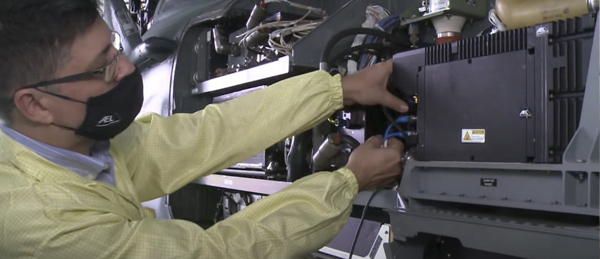2021-09-01
TORCH-X BMS Delivers Enhanced Combat Capabilities to IDF and UK Army
Upgraded version was recently deployed in the Israel Defense Forces (IDF) battalion, brigade and division level and successfully implemented in NATO’s Coalition Warrior Interoperability Exercise.
Elbit Systems recently implemented significant upgrades to the TORCH-X Battle Management System (BMS) in service with several Armies worldwide. Two important milestones recently marked are the deployment of TORCH-X multi-domain capabilities of the Israel Defense Forces (IDF) and the operational demonstration of TORCH-X Battle Management Application (BMA) in NATO’s recent multi-national exercise.
“We dramatically shortened the time of closing the Sensor-to-Shooter processes, or ‘fire circles’ – the time between the detection and location of a target to the attack of that target”, said Brigadier General Yariv Nir, Chief Communications and Information Technology Officer in the IDF C4I and Cyber Defense Division, during a recent media briefing. This process includes receiving information from a variety of sources, sensors, intelligence, operational and legal elements, the processing and dissemination of that information to different stakeholders and, finally, issuing the orders to attack that target, with the information necessary for precision attack.This process has been shortened by 30 per cent-40 per cent.”
At the tactical and operational level, the core that delivers this operational capability is the latest version of Elbit System’s Digital Army Programme known as TORCH-X, which is the main C4ISR system used by the IDF. Recently fielded and empowered with Elbit System’s E-LynX broadband software defined (SDR) tactical communication solution, in order to address the exponential data and video requirements by users that operate in the multi-domain battlefield.
TORCH-X is part of the Israeli military’s digital transformation, designed to convert the battlefield into a digital-based arena. According to Lt. COL Amos Shor, who heads the TORCH project in the IDF Ground Forces’ Weapons Development Department: “Doing this requires all of the systems to work with each other and to connect not only with different systems, but also the weapon and sensor systems. Our system enables the commanders in the headquarters and the tactical commanders to have a clear picture of where the friendly forces are and where the estimated position of the enemy is,” explained he during media briefings. Shor further explained that the goal is that a platoon commander, when looking at his device, has a clear picture of all the forces. “This means everything - the navy, what’s in the air and the ground forces, infantry, tanks, headquarters, reconnaissance units - everything.Understanding the clear picture is our top priority.”
The new combat network system was a central element in forming the IDF’s new Multidimensional Unit that is considered the blueprint for the future IDF ‘multidimensional’ battalions. This unit is in a form of a battalion but with the firepower, maneuverability and terrain dominance of a brigade. The system also supports the IDF’s new Commando Brigade that relies on advanced communications and networking technologies, effectively employing small units empowered by organic intelligence, organic firepower and the use of transport, logistic and fire support from the ground, air and sea.
Elbit Systems also recently implemented the TORCH-X system in NATO’s Coalition Warrior Interoperability Exercise 2021 (CWIX 2021). The Company was selected by the UK Ministry of Defence in 2018 to provide the British Army with the TORCH-X based Battlefield Management Application (BMA) for the Morpheus programme. During the exercise, the NATO interoperable TORCH-X based BMA system was employed to support UK’s Higher Headquarters preparedness activities for Five Eyes and NATO operations. Some 28 nations participated in CWIX, conducting over 10,000 technical interoperability tests across the land, maritime, air and cyber environments. During CWIX 2021, the team from Elbit Systems worked alongside the 13 Signals Regiment and staff from the Land Systems Reference Centre to successfully deliver interoperability assessments of the TORCH-X-based BMA during the exercise.
The TORCH-X combat network system enables the modern combat force to act in the most effective way possible and allows the entire force to fight in the most flexible and rapid way possible, regardless of interference, location and domain.
Such interoperability enables all parties in the battle to communicate, share a common operational picture, deploy weapon systems and attain richness of battle information, based on standardised communications and security protocols. For example, smart rifle sights enable soldiers in the field to mark a target, that will appear on the screen of senior commanders in the operations room. The system calculates the right weapon to use, what is the right munition needed to engage and the exact angle needed to attack. Upon selection and confirmation, the system sends within seconds the target information to a weapon systems’ operator to perform the attack, rapidly closing the sensor-to-shooter loop.
In addition to communications and processing capabilities, the system integrates decision support services to assist officers in processing information and making decisions rapidly. Officers are presented with available order-of-battle and locations of all combat elements, ammunition availability and supply levels. The system accesses all sensors that can follow the target and stores technical data, combat doctrine, safety and legal restrictions that apply to using the different weapons suitable to engage the target. Based on this data, the system selects several alternatives and provides recommendations to the commanders, for their decision.


No Comments